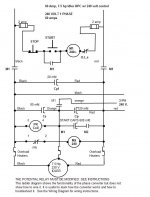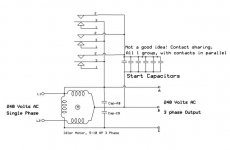jminer99er
Plastic
- Joined
- Jan 14, 2008
- Location
- Sacramento
Heck, where do I start?!
Hello people, I have been in the background reading all this great info for about four months, while gathering electrical stuff for a RPC. I am an electrician, but I have no experience with motors or industrial control work. (Starters, relays, contactors) I did take electronics and have a general understanding.
My dad is a machinist. (Likes to build small steam engines and such) He had a static phase converter that smoked about four years ago, and is too frugal to buy new.
He has two, 3ph mills, and a grinder. The grinder is 2hp. His Kempsmith mill is 3hp. His Bridgeport has three motors on it the biggest is 1/2hp.
I just picked up a Baldor EM3313T Super-E 3ph 10hpDP motor, I have a bunch of run caps, and about 800mf for start caps. I have two 60a 3pole disconnects. I have a bunch of Square D magnetic starters, Nema0 (which I think is to small) Nema1 (which gives a 7.5hp at 230v and 10hp at 460) I don’t have any Nema2 . I also have a few Nema3 (which I think are to big)
I do have a three phase distribution panel I’m going to use.
I’m trying to build according to Fitch’s design for now to get my dad started. (Bells and whistles later)
I have a few questions… (a bunch)
What size contactors do I need for the run contactor? What size for the start contactor? Do I only need two contactors? I have two Arrow Hart contactor that says "1ph 240v 5hp, and 3ph 240v 10hp" its rated for 40A. I have a GE that says "40A 240-600V 1 or 3ph" will one of those work? Will 40A suffice for my contactors? I also could rob a contactor off the Nema1 Mag starters if I need to.
Will I need a Steveco pot relay too? Oh, I have a few Potter & Brumfield time delay relays, I’m not sure where they would fit in circuit.
I do have a few control transformers that would work pri240v sec120v, but the contactors I have are 240v coils, all except one 120v contactor on a Nema1 starter. So for controls I can’t go off of Fitch’s and Im not sure how to do it.
What AWG should I pull to the idler motor? (10hp with 28 FLA) The distance would be about 50’. The wire size would tell me what size breaker to feed the idler with. Let’s say I pull #6 wire, two hots and a ground for the idler, should I bring a neutral too, and do I have to pull an additional dedicated 240v circuit for controls?
How do I protect each machine? (Where to place fusible disconnects?)
Example: from the 60a breaker in my panel run #6 wire to a 3pole fusible disconnect, then to my idler. From the idler take #10AWG to the three phase distribution panel. Bring all the machines to the three phase panel. Being that I only have 15a breakers for the three phase panel, I will have to wire in some fuses for each leg. (I think) The breakers I have are way to expensive to buy they are type EHB, or I would look into getting smaller ones.
This has been my obsession for months now and im ready to build!
Thank for taking your time and reading this, and thank you in advance for any input!
James
Hello people, I have been in the background reading all this great info for about four months, while gathering electrical stuff for a RPC. I am an electrician, but I have no experience with motors or industrial control work. (Starters, relays, contactors) I did take electronics and have a general understanding.
My dad is a machinist. (Likes to build small steam engines and such) He had a static phase converter that smoked about four years ago, and is too frugal to buy new.
He has two, 3ph mills, and a grinder. The grinder is 2hp. His Kempsmith mill is 3hp. His Bridgeport has three motors on it the biggest is 1/2hp.
I just picked up a Baldor EM3313T Super-E 3ph 10hpDP motor, I have a bunch of run caps, and about 800mf for start caps. I have two 60a 3pole disconnects. I have a bunch of Square D magnetic starters, Nema0 (which I think is to small) Nema1 (which gives a 7.5hp at 230v and 10hp at 460) I don’t have any Nema2 . I also have a few Nema3 (which I think are to big)
I do have a three phase distribution panel I’m going to use.
I’m trying to build according to Fitch’s design for now to get my dad started. (Bells and whistles later)
I have a few questions… (a bunch)
What size contactors do I need for the run contactor? What size for the start contactor? Do I only need two contactors? I have two Arrow Hart contactor that says "1ph 240v 5hp, and 3ph 240v 10hp" its rated for 40A. I have a GE that says "40A 240-600V 1 or 3ph" will one of those work? Will 40A suffice for my contactors? I also could rob a contactor off the Nema1 Mag starters if I need to.
Will I need a Steveco pot relay too? Oh, I have a few Potter & Brumfield time delay relays, I’m not sure where they would fit in circuit.
I do have a few control transformers that would work pri240v sec120v, but the contactors I have are 240v coils, all except one 120v contactor on a Nema1 starter. So for controls I can’t go off of Fitch’s and Im not sure how to do it.
What AWG should I pull to the idler motor? (10hp with 28 FLA) The distance would be about 50’. The wire size would tell me what size breaker to feed the idler with. Let’s say I pull #6 wire, two hots and a ground for the idler, should I bring a neutral too, and do I have to pull an additional dedicated 240v circuit for controls?
How do I protect each machine? (Where to place fusible disconnects?)
Example: from the 60a breaker in my panel run #6 wire to a 3pole fusible disconnect, then to my idler. From the idler take #10AWG to the three phase distribution panel. Bring all the machines to the three phase panel. Being that I only have 15a breakers for the three phase panel, I will have to wire in some fuses for each leg. (I think) The breakers I have are way to expensive to buy they are type EHB, or I would look into getting smaller ones.
This has been my obsession for months now and im ready to build!
Thank for taking your time and reading this, and thank you in advance for any input!
James








